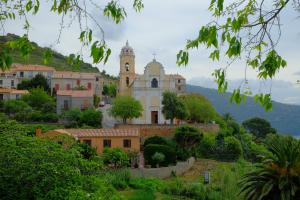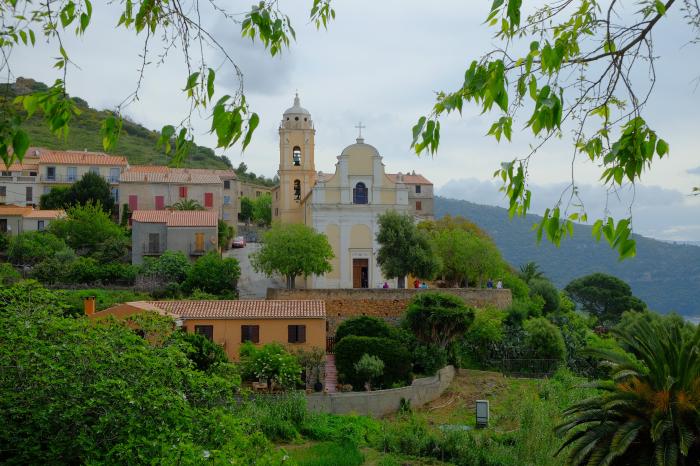Category: Architecture Photography
Post Type:
Photography
Mixed Media: None
Pays
one point
and 2 member cents.





© Copyright 2024. supergold All rights reserved.
supergold has granted FanStory.com, its affiliates and its syndicates non-exclusive rights to display this work.
Posted: April 24, 2014
      |
in Cargese, Corsica
the Greek church
by supergold
Interested in this? Contact The Artist
You can own this. Offers accepted. Information
the Greek Church in Cargèse:
The village was established at the end of the 18th century by the descendents of a group of immigrants from the Mani Peninsula of the Greek Peloponnese who had first settled in Corsica in the 17th century. The economy of the village is now based around tourism. Cargèse is noted for having two 19th-century churches that face one another across a small valley overlooking the harbour and the sea. One was built by the descendents of the Greek immigrants and the other one by Corsicans.
The second half of the 17th century witnesses a substantial emigration from the Mani Peninsula of the Greek Peloponnese. This was mainly driven by the wish to escape from the control of the Ottoman Turks but was also prompted by the lack of arable land and by the intense feuding between different clans.
In 1669 the Ottomans captured Crete, and then a year later in 1670, as part of a strategy to strengthen their control over the inner Mani, they built the fortress of Kelefa on the western side of the Mani peninsular. A number of the inhabitants of the small town of Oitylo (or Vitylo), which lay just 1.5 km west of the fortress, wished to emigrate to avoid the taxation imposed by the Ottomans and negotiated with the Republic of Genoa, which then controlled Corsica, for permission to settle on the island. The Republic offered them a choice of three locations in the Province of Vico and in October 1675 a group of 730 colonists departed from Oitylo and after a short stay in Genoa arrived in Corsica on March 14, 1676. They settled in Paomia, the site of several abandoned hamlets, which is situated 4 km east of the present village of Cargèse at around 450 m in altitude on a hillside overlooking the Gulf of Sagone. The location has similarities to that of Oitylo which also overlooks the sea. The settlers agreed to pledge loyalty to Genoa and to recognise the spiritual authority of the Pope but were allowed to retain the Greek rite as prescribed by the Holy See in Rome.
by supergold Interested in this? Contact The Artist
The village was established at the end of the 18th century by the descendents of a group of immigrants from the Mani Peninsula of the Greek Peloponnese who had first settled in Corsica in the 17th century. The economy of the village is now based around tourism. Cargèse is noted for having two 19th-century churches that face one another across a small valley overlooking the harbour and the sea. One was built by the descendents of the Greek immigrants and the other one by Corsicans.
The second half of the 17th century witnesses a substantial emigration from the Mani Peninsula of the Greek Peloponnese. This was mainly driven by the wish to escape from the control of the Ottoman Turks but was also prompted by the lack of arable land and by the intense feuding between different clans.
In 1669 the Ottomans captured Crete, and then a year later in 1670, as part of a strategy to strengthen their control over the inner Mani, they built the fortress of Kelefa on the western side of the Mani peninsular. A number of the inhabitants of the small town of Oitylo (or Vitylo), which lay just 1.5 km west of the fortress, wished to emigrate to avoid the taxation imposed by the Ottomans and negotiated with the Republic of Genoa, which then controlled Corsica, for permission to settle on the island. The Republic offered them a choice of three locations in the Province of Vico and in October 1675 a group of 730 colonists departed from Oitylo and after a short stay in Genoa arrived in Corsica on March 14, 1676. They settled in Paomia, the site of several abandoned hamlets, which is situated 4 km east of the present village of Cargèse at around 450 m in altitude on a hillside overlooking the Gulf of Sagone. The location has similarities to that of Oitylo which also overlooks the sea. The settlers agreed to pledge loyalty to Genoa and to recognise the spiritual authority of the Pope but were allowed to retain the Greek rite as prescribed by the Holy See in Rome.
Mixed Media: None
 Recognized |


the Greek church
by supergold

You need to login or register to write reviews. It's quick! We only ask four questions to new members.
© Copyright 2024. supergold All rights reserved.
supergold has granted FanStory.com, its affiliates and its syndicates non-exclusive rights to display this work.


